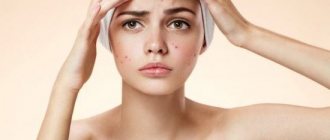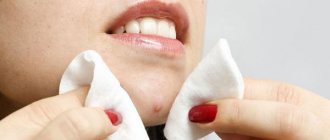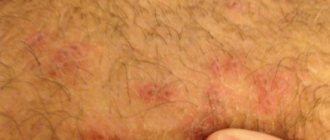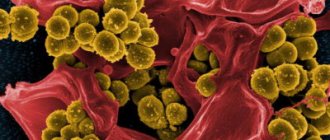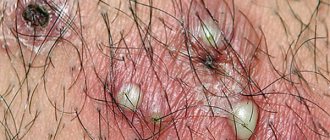Most often, teenagers experience rashes on the chin, forehead and face in general. During puberty, many people experience acne. This is a normal phenomenon that 90% of people go through.
At the same time, acne at the age of 30 in women is also not uncommon. Localization – neck, forehead, chin. The defect occurs for a number of reasons and requires timely contact with specialists. It is important not to let the problem take its course.
Why do acne appear?
The occurrence of acne is influenced by exogenous and endogenous causes. The latter include changes in the body.
Note:
- Hormonal imbalance.
- Use of medications.
- Problems with the functioning of the adrenal glands, ovaries or pituitary gland.
- Internal diseases.
- Infections.
We can also identify external reasons for the appearance of acne on the face after 30 years in women:
- Stressful situations.
- Bad habits.
- Poor skin hygiene.
- Failure to comply with the principles of rational nutrition.
- Using poor quality cosmetics.
Stressful situations
Acne may also be caused by stress. Young women have problems with nerves when combining work, household chores and childcare. Under extreme stress, adrenaline is released, which can cause an increase in blood flow. As a result, the pores open up, bacteria penetrate into them and inflammation appears.
Hormonal imbalances
Hormonal changes stimulate the functioning of the sebaceous glands. Excess fat provokes skin rashes. Acne also appears when using hormonal contraception.
An interesting fact regarding the causes of acne on the face
Experts say that diseases that affect the human body from the inside manifest themselves on the skin. The face is divided into zones “responsible” for a certain type of internal organ. A small or large purulent rash on the face “speaks” of problems with internal organs.
- The forehead is responsible for the functioning of the bladder, digestive system, and liver. The upper part of the forehead is affected by the large intestine, the lower part is affected by the small intestine. Pimples between the eyebrows are a sign of disease of the exocrine gland (liver).
- Temple area – problems with the gallbladder. Unhealthy complexion, yellowing of the whites of the eyes, headaches accompanied by pimples on the temples are a sign of gallbladder disease.
- The eye area “speaks” of emotional problems, stress, sleep disorders, chronic depression, and fatigue. Fatty pimples near the eyes are a sign of stagnant processes in the kidneys, accompanied by the accumulation of sand and stones.
- The nose is an “area” of the cardiovascular system. A bluish color of the lips, nasolabial triangle, accompanied by rashes on the nose is a dangerous phenomenon, indicating a pre-infarction condition of the patient.
- Redness, vascular network, wide pores, pimples on the cheeks indicate problems with the lungs. The right side indicates damage to the right lung, the left - accordingly, the left.
- The area of the stomach, pancreas - the bridge of the nose.
- The chin area is responsible for the reproductive function of a woman, the work of the ovaries and appendages. In men, this is a sign of the development of prostatitis. The condition of the epidermis on the chin represents pelvic diseases.
- A large, small rash on the face at the corners of the lips, in the mouth area is a sign of digestive disorders. Colic, disturbances in bowel movements, accompanied by pimples near the mouth - a sign of diseases of the gastrointestinal tract.
The above methodology is informative, reliable, but not ideal. The diagnosis will be made by a doctor after examining the patient, studying the characteristics of the rash, its location, type, and duration of damage to the skin.
Treatment
To cure acne in women after 30 years of age, it is necessary to treat the underlying disease. For inflammation of the sebaceous glands, medications are prescribed that eliminate dead cells, reduce sebum production and reduce bacterial flora.
Acne therapy has the following objectives:
- Protects against the appearance of comedones.
- Cleanses pores.
- Slows down the reproduction of pathogenic organisms.
- Reduces sebum secretion.
- Treats inflammation on the skin.
Cosmetic procedures are also popular. Professional peeling contains concentrated acids. This procedure can remove accumulated dirt and grease.
The top layer of the dermis is removed well, and the skin becomes smooth and pimples disappear. Cryomassage is a cold therapy using liquid nitrogen, which cleanses the skin of various rashes. Laser resurfacing is an effective method for eliminating subcutaneous acne and early wrinkles.
Medicines
Therapy can be started only after an accurate diagnosis and examination has been determined.
To combat the disease, doctors mainly prescribe external remedies:
- Baziron has been successfully used for various types of acne.
- Metrohyal is relevant for inflammatory processes.
- Zenerite helps destroy bacteria and also dry out inflammation.
Other popular products worth noting are salicylic acid, Skinoretin and Clenzit. For problems with the digestive system, Polysorb, Enetrosgel and Smecta are used. Probiotics Normabact and Hilak Forte are also used. Remember that rashes may occur with prolonged treatment with antibacterial agents.
Traditional methods
Acne in women over 30 can be cured using folk remedies.
Try the following recipes:
- Using lemon juice you can get rid of excess fat. Prepare lotion from water and juice. Mix these components in equal quantities.
- Make a special mask from milk, ground almonds and salt. Distribute the mixture onto problem areas. Then wipe the inflamed areas with calendula tincture.
- To exfoliate, mix fine sea salt and ground coffee.
- A good mask can be made from sour milk and green clay.
Before peeling, the skin should be prepared. The face should be steamed over a container of hot water. Then the scrub is distributed over the moistened surface of the skin. Massaging is performed in a circular motion.
Factors that provoke the appearance of rashes
Why do acne appear in women in adulthood? The main reasons for this aesthetic difficulty are:
- Cosmetical tools. The selection of facial care products should be taken very seriously, because the wrong choice or the purchase of low-quality facial cosmetics can lead to clogged pores. In addition, the normal functioning of the sebaceous glands will be disrupted. When using foundation or powder daily, the skin does not receive the necessary amount of nutrients and oxygen,
- Allergic reaction. One of the most common causes of rashes and acne is an allergic reaction, which can occur to food containing chemicals, medications, cosmetics, dust or plants. Most often, such acne can either suddenly appear or suddenly go away after taking antiallergic medications,
- Infections and bacteria. A fairly common cause of acne after 40 years of age is the action of all kinds of bacteria and pathogens that, when they come into contact with the skin, can cause inflammatory reactions. Such infection also occurs through a mobile phone, touching the face and other parts of the body with unwashed hands, constant contact with animals that are carriers of many infections,
- Beauty procedures. Acne appears due to poor quality or improper implementation of cosmetic procedures. With the help of the hands of a cosmetologist or thanks to poorly disinfected devices, bacteria can penetrate into the skin, causing pimples and acne.
- Shampoos and balms. If you choose the wrong hair care products, rashes often appear on the forehead or along hair growth,
- Hormonal changes. In adult women after 45 years, hormonal changes occur in the body, which is rebuilt in a new way during this period. Hormonal imbalances directly affect the structure and condition of the skin. It is worth noting that with endocrine disorders, acne can also appear on the lower back, which leads to discomfort and many inconveniences,
- Failure in the digestive system. The health of the skin also depends on the health of the digestive system and intestines. The first signs of disruption of the internal organs of the gastrointestinal tract are changes in facial skin color and the appearance of acne,
- Violation of metabolic processes. Due to an unbalanced diet, not only inflammation can appear on the skin, but also acne. When insufficient oxygen and nutrients enter the cells, the skin becomes dull and wrinkles and acne may appear.
How to treat skin diseases? Today, there are many methods that will help you quickly and effectively forget about pimples and acne. Of course, it is initially recommended to cure all existing diseases that may indirectly or directly affect the development of inflammation. The main medicinal drugs that are used in the rehabilitation of people with skin ailments are:
- antiandrogens,
- retinoids,
- tetracyclines.
All of them are capable of influencing bacteria that cause inflammatory reactions on the skin. If necessary, doctors can also prescribe sedative medications that will help calm and reduce the patient's stress.
Dermatologists advise using creams based on salicylic acid, which can normalize oily skin, eliminate inflammation and combat pathogens and bacteria. Creams based on extracts of calendula, sage, Atlas cedar and eucalyptus perfectly dry out pimples, relieve irritation and significantly improve the condition of the skin on the face.
Traditional medicine recipes that will help eliminate inflammation and improve the structure of the skin are becoming increasingly popular. This is explained by the fact that the components of masks and decoctions contain only natural ingredients that can enrich the skin with beneficial vitamins and microelements, while nourishing the skin and improving metabolic processes. Frequently used methods are:
- Brewer's yeast. The substance contains a large amount of B vitamins, which improve metabolic reactions in cells. It is recommended to use yeast in the morning, 2 teaspoons on an empty stomach,
- Tea tree oil. This type of oil is quite often used in cosmetology to combat inflamed acne. It is recommended to apply the oil directly to inflamed areas of the face,
- Aloe juice. The medicine can heal the skin in a short period of time. Aloe juice can be used to lubricate problem areas, and can also be used as one of the components of masks,
- Blue clay. A blue clay mask should be done twice a week for 10 minutes. Clay helps prevent inflammation and acne, perfectly cleanses and nourishes the skin.
Any medicine for acne on the face must have anti-inflammatory and disinfectant properties. The main task of such drugs is to stop the further spread of infection and prevent the formation of pus.
For this purpose, dermatologists prescribe both products for external use (all kinds of ointments and gels) and tablets for oral use.
Gels/ointments
- Zinc ointment
- Salicylic
- Ichthyol
- Sulfuric
- Streptocide
- Retinoic
- Tetracycline
- Heparin
- Synthomycin
- Erythromycin
- Levomekol is one of the best ointments for acne and pimples on the face
- Baneocin
- Metrogil
- Klindovit
- Curiosin
- Klenzit
- Vishnevsky ointment
- Zenerite
- Differin
Antibacterial and anti-inflammatory medications for acne in the form of ointments and gels are applied point-by-point. They are applied exclusively to rashes, but not to the entire face. After 10 minutes, the remaining product must be removed.
Therapeutic compresses of this kind are made several times (2-3) a day for a week or 10 days. If you continue this therapy further, the epidermis will stop responding to it.
Pills
Even greater caution requires anti-acne pills, which can only be taken as prescribed by a doctor. Self-medication is strictly prohibited. The course of therapy ranges from 5 to 10 days.
- No drug can cope with acne better than an antibiotic: erythromycin, oxytetracycline, minocycline, lymecycline, doxycycline, trimethoprim are prescribed to combat acne.
- Hormones: progestogen, cyproterone, spironolactone, estrogen, cortisone.
- Retinoids.
In addition to ointments (gels) and tablets, the doctor may recommend other pharmaceutical preparations for acne and acne on the face, selected individually.
Other medicines
The following medications can be purchased at the pharmacy:
- hydrogen peroxide can be added to homemade masks or treated with rashes once a day for disinfection,
- vitamins for acne (all group B, retinol and tocopherol) can be drunk (in the form of capsules), injected (in the form of injections), included in home masks (contents of capsules and ampoules),
- Badyaga, according to the recipe, is diluted with water, after which it is applied as an application to acne,
- Iodine is used extremely carefully so as not to burn the skin,
- don’t know what to wipe your face with acne - salicylic acid is an ideal remedy for this,
- A cotton pad is soaked in chlorhexidine, after which the problem area of the face is cauterized,
- aspirin is crushed into powder and diluted with water to a creamy consistency: a mask with aspirin is applied pointwise to acne.
Only a doctor can advise how to treat acne on the face at home using medications. It is extremely dangerous to use them without a specialist’s prescription.
If you have no desire to resort to the help of pharmaceutical products, there is a more gentle way to solve the problem - special cosmetics.
On the face
Acne on the face of adult women most often appears before, during or after ovulation.
This is mainly due to hormonal disorders or gynecological diseases. Hormonal acne is usually localized on the forehead, but can also cover other areas of the face - the cheekbones, eyebrows, and chin.
However, hormones are not the only cause of rashes.
Inflammatory processes on the face can be caused by malfunctions of the digestive and endocrine systems, increased oily skin and hyperkeratosis (thickening of the upper stratum corneum of the skin), allergies, poor nutrition and failure to comply with basic hygiene rules.
On the sternum
The reasons for the appearance of acne in the area on the chest are the same as in other cases.
Therefore, before starting the fight against unwanted skin defects, it is better to consult a doctor.
After identifying the exact cause of the inflammatory processes, the doctor will tell you how to get rid of acne on the sternum and throughout the body.
In an intimate place
In the intimate area, acne most often becomes a random and harmless inflammation.
In this zone, hair grows more actively than in other areas of the skin; it is denser. Therefore, slight compaction at the root of the hair should not be a cause for concern.
- a boil that occurs when there is severe inflammation of the sebaceous gland and the addition of a bacterial infection,
- fatty cyst (subcutaneous white lump that occurs due to the accumulation of large amounts of sebum),
- purulent seals on the mucous membrane of the genital organs, developing with some sexually transmitted diseases.
On the buttocks
Acne on the buttocks most often occurs due to insufficient hygiene or wearing synthetic underwear that does not allow air to pass through and does not allow the skin to breathe normally.
Acne during adolescence is normal and does not cause concern to anyone. In this case, it is only necessary to control the process of their appearance so that complications do not arise.
On the face
On the sternum
In an intimate place
On the buttocks
Acne prevention
To protect your skin from acne, follow these simple recommendations:
- Maintain good hygiene.
- Do not touch your face with dirty hands.
- Monitor the quality characteristics of the cosmetics you use.
- Wash your face with cool water in the morning and use special cleansers in the evening.
To maintain good skin condition, it is necessary to avoid stressful situations. It has a positive effect on skin health and normal sleep and rest. The diet should include healthy foods. It is important to limit the consumption of fatty, starchy and sweet foods. Do not forget to consult a doctor if you have health problems, especially if internal organs are affected.
